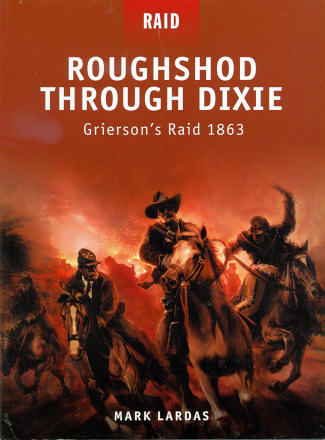 This
series from Osprey is slowly becoming a favorite of mine. This time, Raid goes
to the Civil War and picks probably the most successful cavalry raid of the
conflict; Grierson's raid of 1863.
This
series from Osprey is slowly becoming a favorite of mine. This time, Raid goes
to the Civil War and picks probably the most successful cavalry raid of the
conflict; Grierson's raid of 1863.|
Title: |
Roughshod through Dixie: Grierson's Raid 1863 |
|
Author: |
Mark Lardas |
|
Publisher/Distributor |
Osprey Publishing |
|
Price |
$18.95 MSRP |
|
Reviewer: |
|
| Notes: |
64 pages, 7¼ x 9¼ inches, softcover ISBN:978-1-84603-993-5 |
 This
series from Osprey is slowly becoming a favorite of mine. This time, Raid goes
to the Civil War and picks probably the most successful cavalry raid of the
conflict; Grierson's raid of 1863.
This
series from Osprey is slowly becoming a favorite of mine. This time, Raid goes
to the Civil War and picks probably the most successful cavalry raid of the
conflict; Grierson's raid of 1863.
When the war began, it was the Confederate Army who were the masters of cavalry. The Union troops were not brought up around horses in terms of riding them. Most were urban dwellers whose experiences with horses were being drawn by them. In the south, there wasn't the heavy urbanization so most men learned to ride early and improved on that as time went on. In the south were the big horse races so horses were as much a way of life as were plantations.
The result of this was a series of relatively successful raids into Union territory by some well known cavalry officers like J.E.B. Stuart and John Hunt Morgan. Their raids were mainly designed to keep Union troops in the areas behind the lines to defend against these raids.
By mid-war, the Union was advancing, albeit rather slowly and concentrating on control of the waterways. Grant has been trying to take Vicksburg for some time and had been failing rather badly. What was needed was a major diversion that would hopefully draw away troops or at least prevent them from being reinforced quickly. A plan was devised in early 1863 that involved the 6th and 7th Illinois and 2nd Iowa cavalry regiments. These units had worked together for some time so knew each other well. They were also successful horsemen and led, for the most part, by competent officers.
Benjamin Grierson was initially a school teacher who had moved to Illinois to set up business. When the war started, thanks to his friendship with Illinois' governor, became the aide-de-camp for the commanding general of Illinois military units. An opening in the 6th Illinois cavalry regiment came available and so Grierson petitioned the governor, who made him a major and put him in the unit. He proved to be a very competent officer and after petitioning of the unit's officers eventually replaced the commander. The petition was accepted and Grierson was promoted to colonel. He then led his unit along with others to several successful campaigns.
When Grant was looking for someone to provide a diversion from the stalemate at Vicksburg, it was to the Illinois and Iowa units that has worked so well together and provided such success. The basic plans were developed that this raid would cut and destroy as much of the Confederate railway system east of Vicksburg as possible, preventing supplies and reinforcements. It was also hoped to draw away units as Grant crossed the Mississippi south of Vicksburg. To cut the story a bit short, Grierson was chosen to command the raid and given full rein to do it as he saw fit. He trimmed his units down to bare necessities and brought along six small cannon that had proved to be useless in normal combat, but in this case, was a real boon.
His raid from northern Mississippi through the south for two weeks of rampage and destruction was incredibly successful. The Confederates never did catch him and he ended up in Baton Rouge with most of his force still intact. It was by far the type of history that outshines any fictional tale. A gripping story that will keep you engrossed. A book I found to be a fascinating read and one that I can highly recommend to you.
August 2010
For more on the complete line of Osprey books, visit www.ospreypublishing.com. In the US, it is Osprey Direct at 44-02 23rd St, Suite 219, Long Island City, NY 11101., where you can get a catalogue of available books.
If you would like your product reviewed fairly and quickly, please contact me or see other details in the Note to Contributors.